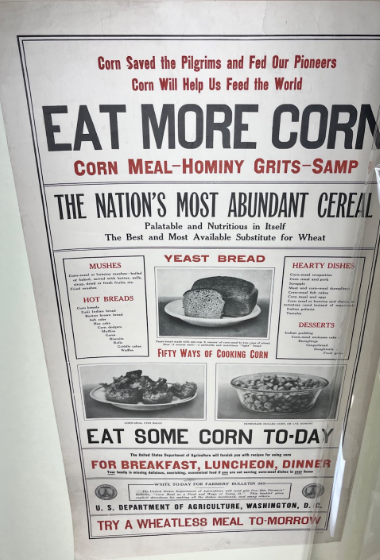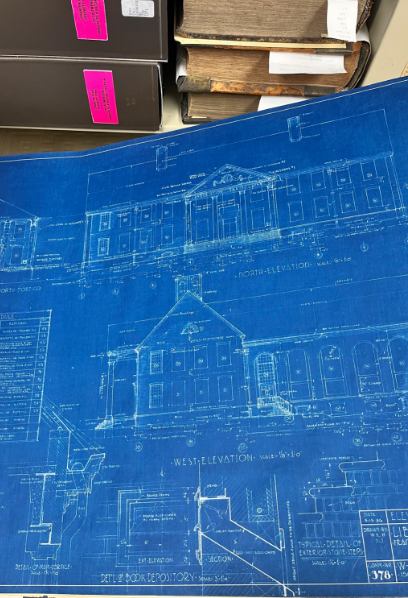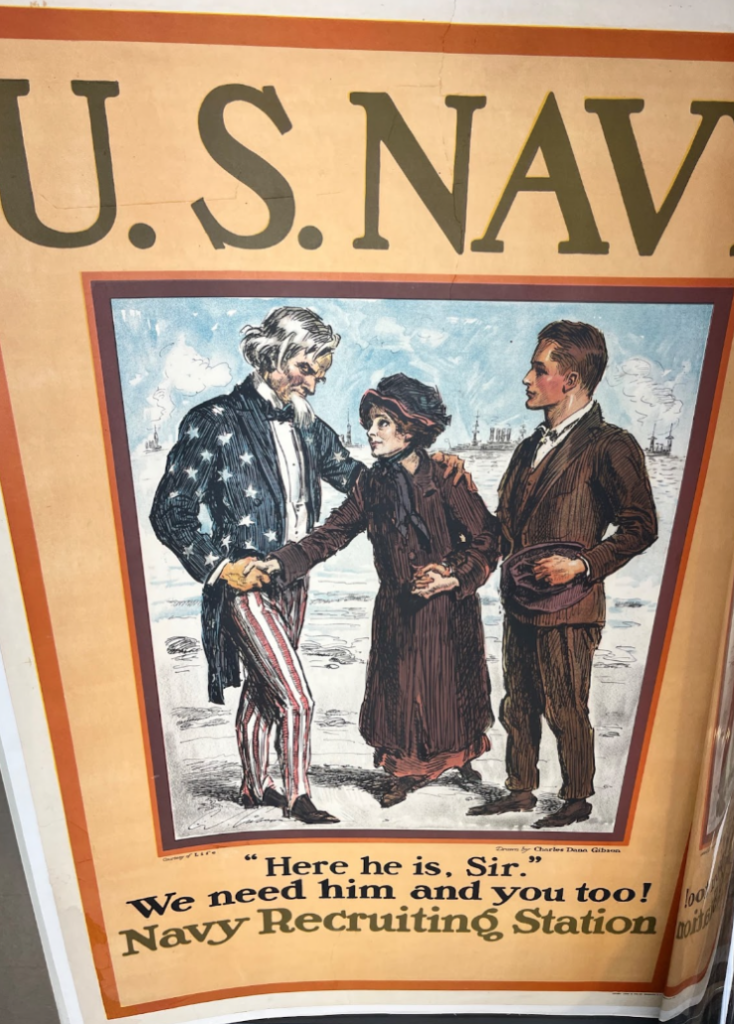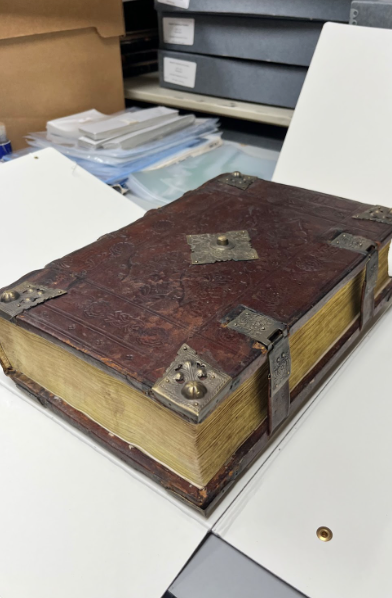I had the pleasure of interviewing Associate Librarian for Archives and Special Collections Christopher Raab. The department is made up of Mr. Raab, Louise Lobello, and Heidrun Perez. The archives in Martin Library hold some of the most interesting timepieces. I got to see a 500- year-old book written in Latin, propaganda for WWI, and even a poster to urge citizens to eat more corn. I hope every student has the chance to see our amazing collection!

Can you please give me a description of your job?
My position is to oversee the archives and special collections, including services such as: workshops to supplement the faculty to deliver the curriculum, research services for faculty to students, and many more. We curate specific collections by cataloging, finding, sourcing, and preserving. We have the college archives, special collections such as manuscripts, rare posters, maps, and rare books. And our digital collection. We have about 80 manuscripts, from local organizations, i.e. history of the Junior League or the Lancaster Farmland Trust. And personal paper collections, such as the Reynolds Papers or the Carolyn Perk Collection. We have lots of fun posters. We have about 140 WWI sourcing from that time.

How did you get the collection?
The WWI collection has a bit of mystery behind it. We normally know the background of the pieces, but this one has an air of mystery. It was part of the collection but no one has any definitive background. We suspect they arrived at the collection during the turn of the century, around the 1930s. Because the library is a partial depository of federal documents, so the posters were government documents. They were distributed for recruitment, homefront activities. We also have a huge film collection, large engravings. In the 19th century, people used to create and display large engravings.
What are those?
It is a steel plate, and you engrave the design. Then you make a print of the plate. They are a form of art.
How did you get into the field of archives?
I was a History Major at Carnegie Mellon University. I knew I did not want to teach history.
Why no teaching?
I did not want to handle a classroom (laughing) full of kids. But I was always interested in the research part of writing papers and discoverting historical evidence. The detective, soothing part. And that is exactly what this job ends up being. You are basically trying to solve riddles. Trying to find answers from the public, students, alumni, other professional departments, etc. Everyday is different.
How did you start working at Franklin and Marshall?
I have always worked at colleges. Before coming here, I worked at SUNY New Paltz in the Hudson Valley. I worked there for about five years doing special collections. But I am from Eastern Pennsylvania so when the job opened up, I applied. Plus, the collections here are very fascinating. We have a lot of Pennasylvannian Germans. I have been working here for about 21 years.
Over the 21 years you have been here, what has changed the most?
The technology. My career spanned the transition from analog to digital. So when I started working the internet was brand new and print based. Now everything is born digital. Alot of collections we digitized to make more available. We used to be much more in person. Now, everything is mostly online, people email me questions rather than coming in person. We now have 35 digital collections as well. It increases access, discovery, and research quality. However, we lose the human connection, the one-on-one.

With all the advancements in technology, has it helped or hurt the archives?
It is a double-edged sword. It is good because it increases access and discovery. But, it hinders the Serendipity. Of just stumbling across something from its proximity to other collections around it. But, there is digital Serendipity as well. If I digitize something, someone from across the world can stumble across it.
Have less students come to you with everything online?
The straightforward questions have dropped off. But, the deeper questions are actually more frequent. I think people’s curiosity has piqued because they have discovered something. Or, they want a deeper dive research experience. So, I get more focused questions than before. More quality of questions over quantity.
What is one thing you wished students knew about your job?
The department is available 12 months a year. We are a resource for you to utilize. If you take advantage of it, it will only help you achieve more of your F&M experience. No matter your major, there is something applicable in the collection to you. From the history of hospitals to astronomy, we are here to help! I have helped students throughout the years with papers on the influenza outbreak in 1918. We have a great collection on that.
What has been the most interesting question you had to solve?
I’ve been asked “What is the small ‘T.S.’ stone marker next to Buchanan House and the Dog Park all about?” While T.S. can mean many things, it’s actually an old 19th century property marker for the Theological Seminary now located across the street. F&M originally sold the land (where Winter Visual Arts Center now stands) south of Old Main to the Seminary in 1871. F&M purchased the land back from the Lancaster Theological Seminary in 1905, but never removed the old property marker.
What is your favorite part of your job?
It is always new and engaging so that keeps it fresh. New collections, new technologies, new curriculums, or even new professors. But I also enjoy working with students. It is a lot of fun because I see their energy, enthusiasm, and creativity.
What is your favorite thing in the collections?
The thing that I have not yet discovered. I am pretty familiar with a lot of the stuff, but I still come across things I never knew we had. I know when I retire, whoever is next will still be discovering something new.
Can you describe the archives?
Think of it as a very full, yet organized closet. It appears very overwhelming, but there is a method to the madness. Like an organized store room.
How many books are there?
We have about 9,000 rare books. Our oldest book is about 500 years old and comes from Nuremberg, Germany. It is a commentary on the 10 Commandments.
I have heard many stories of F&M being haunted. What is your opinion?
Well, Old Main is built on Gallows Hill where there were public executions. But, I have heard people saying they have felt presence in other buildings. But I will leave that up to your readers to figure out (Here is a link to F&M’s ghost stories! https://library.fandm.edu/archives/fastfacts/ghoststories).
What do you think the value of preserving all of the pieces is?
History is cyclical and human nature is repetitive. It is also inspirational because we learn by example. So, knowledge is a building block process.
What is your procedure in preserving everything?
We create a stable environment for no matter the resource. We have acid-free folders. Then, those folders go into acid- free acid-buffer boxes. Then, those go into the vault. It is secured with an alarm and waterless fire suppression system. If there is a fire, sprinklers do not go off because that will ruin the collections. This releases a gas that kills all the oxygen so the fire cannot spread.
For a fun question to end on, do you ever hear any gossip from students in Martin Library?
I don’t hear students, but more institutional gossip. So many departments converge, so I hear more on the institutional level. I have to be careful what I say here… The archives are like the historical centerpiece of the college. So I hear bits of information. News and gossip comes in, but never comes out. I have to respect confidentiality.

Senior Abby Glickman is The Onion Dip Editor. Her email is aglickma@fandm.edu.